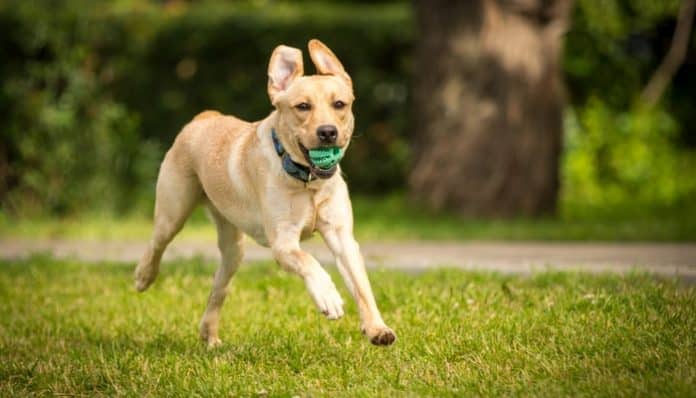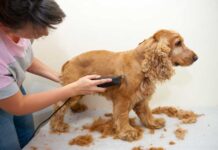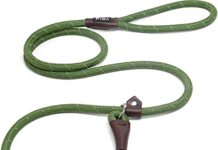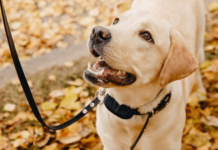You will be surprised at the levels of acrobatic skills they are capable of, not to mention jumping and running around.
All this activity will lead it to huff with its tongue out in need of water. It is essential to keep your dog hydrated.
Active Dogs: The Benefits for Dogs and Their Owners
You must ensure that your dog always has fresh and clean water.
A dog’s body is made up of 80% water, which is a little higher than what it is for humans, which is only about 70%.
This should give you an idea of why dogs need water so frequently. Especially during the summer or if the sun is too hot, and when the dog goes through vigorous physical activity, you need to give it water as soon as you see it.
Dogs can dehydrate when they don’t get the required amount of water daily. Dehydration can cause serious problems if your dog is left without water for long periods or if they are ill.
That leads to the question: how long can a dog go without water?
The answer is; not long. It would be best to keep your dog hydrated to ensure good health.
How Much Water Should Your Dog Drink
More than 70% of your dog’s weight is made up of water. So, your dog needs to consume this much water daily to be healthy and hydrated.
So how much should your dog drink per day? The general guideline is that your dog should drink an ounce of water for every pound it weighs daily.
So if your dog weighs 75 pounds, it should ideally drink 2 liters of water daily. Although this might seem like a lot, you must remember that this must be spread throughout the day.
You also need to support this daily moisture of your dog with treats as well as water.
Why Isn’t Your Dog Drinking Water
Usually, a dog will be very regular at maintaining its water intake. It’s instinctive for them to seek out water when they are thirsty. So should you be concerned if your dog isn’t drinking water even when it is offered?
Your dog’s refusal to drink water even when thirsty might be due to underlying issues.
It may be due to a simple reason like an upset tummy or more severe issues like a blockage of the urinary or intestinal tract.
You need to take prompt action if you notice that your dog has stopped eating or drinking. Another reason your dog refuses to drink might be experiencing consistent diarrhea or vomiting.
This can be a more serious reason for concern, as these conditions lead to a rapid loss of moisture while your dog isn’t drinking enough water to replenish it.
Causes Of Dehydration In Dogs
Dogs might get dehydrated due to an underlying illness, such as fever and diarrhea. Water simply not being available is usually one of the first reasons for a dog to get dehydrated. The common cause might be that the owners accidentally left the dog alone without providing water for its drink.
Harsh weather might also result in dehydration for dogs. You must remember that it is not just intense heat that causes dogs to get dehydrated, but also cold temperatures causing severe dryness, resulting in dehydration for your dog.
So to avoid this dangerous condition for your dog, you must ensure that it always gets a fresh supply of clean water.
Signs Of Dog Dehydration
You can mostly tell a dog is dehydrated by how they look. Some visible signs that a dog is thirsty are sunken eyes, a dry nose, an exposed tongue while panting, and agitated movements.
However, every dehydrated dog might not have these symptoms. Sometimes there might be no symptoms if a severe illness is causing your dog to be dry.
Being an owner, you need to keep an eye out for any such symptoms in your dog and investigate further if you feel that your dog is indeed losing fluids. You can do this by checking if its mouth is dry or the saliva has become thick.
You can also pull its scruff to see if the skin is returning to its original form. This can mean dehydration as a dog’s skin loses its elasticity.
The gums are naturally a moist area of your dog. You can lift its lips and run a finger over its gums to see if it’s tacky or dry. Dry gums might mean that the dog needs a drink soon. Check if the nose is dry or not, as the dog usually lick their noses.
‘Check the color of your dog’s urine. There is nothing to worry about if it is pale or light yellow. So if your dog’s nose is flaky, dry, or cracked, it can mean that the dog is dehydrated.
The darker the shade of yellow the urine is, the lesser hydrated your dog is.
Read Next – Petrainer Dog Training Collar [100% Waterproof]
How Long Can My Dog Go Without Water
Water is an essential daily requirement for dogs. If your dog refuses to drink the water for some reason, then it is a good idea for you to know how long it can safely go without drinking any water.
Usually, a dog can safely go 6-10 hours without water. So you don’t necessarily need to panic if you forgot to top up its water bowl before you left for work.
You need to provide it with the required water as soon as you get home and be sure never to leave without delivering it water intentionally.
Some people might do this, so the dog does not pee inside the home, but you should never follow this.
A dog can survive up to 72 hours without drinking any water, but it will start to show symptoms of dehydration after the first 24 hours.
Going beyond this time without water can cause irreparable damage to your dog’s well-being. Discussed below are the experiences the dog would have as it goes each day without water.
Day 1
After a full day of having no water, your dog will get restless as it will continue to look for water. Your dog needs water daily to cool down, so an entire day without water will result in less energy than usual.
Your dog will start to pant more heavily as it gets more dehydrated. In such a case, you need to give them fresh water and foods rich in moisture in small doses to help them rehydrate and gradually cool their bodies.
Day 2
A second day without water makes the dog desperate to relinquish its thirst. Your dog might have some behavior issues and display signs of inevitable weakness that will start to sink in. your dog will get lethargic, and its mobility will get limited.
It would help if you kept them in a quiet area of your house as you attempted to rehydrate them. Use a clean soaked washcloth to dab some water on its gums.
This might get it to encourage them to drink more. If your dog has had diarrhea or vomited during this time, it needs urgent medical attention.
Day 3
Three whole days without food and water is fatal for most dogs. At best, it is in very critical condition.
Your dog is bound to be weak, lazy, and unable to walk. It is crucial that the dog is rushed to the vet and gets rehydrated through medical attention as soon as possible.
The veterinarian can administer IV fluids to replenish the lost fluids to avoid imminent organ damage at this stage.
What To Do For Dog Dehydration
You can change the dog’s water to ensure it is clean and fresh. When heading outdoors with your dog for a more extended period, remember to take a bottle or jug of water with you so that your dog can drink from it from time to time.
If you leave the dog for a few days, you can go to a water fountain or self-filling water dispenser so your dog can drink from it even when you are not around.
You can give your dog fresh fruits and vegetables to keep them hydrated and in a relaxed environment with proper ventilation.
If your dog gets too sick, ensure that the vet gives it the required medical attention, such as IV fluids or other medicine. You can even try fluid therapy at home.
Canned food is also an excellent way to keep your dog hydrated, so get the best-canned food. Plenty of treats available in the market are moisture-rich; you can also try these.
You can add a little variety by adding some flavor to their beverages. You can use bone broth to make them some dog popsicles or add some goat’s milk to their food.
On a hot day, you can give your dog frozen treats when you have to spend time outdoors with your dog. These tasty alternatives will add much-needed moisture to their food.
Read Next – The best dog food, according to experts and veterinarians
In Conclusion
For many of us, dogs are more than just pets that entertain or guard our homes. Most of us think of these furry paws as members of our family.
So we must ensure that their essential needs, such as water, are being taken care of.
We must ensure that our best companions are not suffering from dehydration and are always well cared for.
Why Dogs Are the Perfect Pets for Outdoor Living
Dogs have been man’s best friend for centuries. Loyal, loving, and always there for a pat on the back or a quick game of fetch, dogs make great outdoor pets. They love to romp in the grass, roll in the mud, and chase a good game of frisbee.
And even if you don’t live in an area where it’s warm all year round, a dog can still be your go-to buddy when the sun starts to set. Below are three reasons why dogs are the perfect pets for outdoor living.
Dogs are Great Companions on Outdoor Adventures.
Whether hiking, camping, fishing, or just taking a walk, having a dog by your side makes outdoor activities much more enjoyable.
They’re always up for a game of fetch and happy to lay down by your side while you take a break for a snack. Dogs love to explore new surroundings, so taking them on hikes or camping trips will keep them busy and entertained.
Dogs Are Great for Keeping You Active and Fit.
Dogs are pack animals; as such, they love to be around people and other animals. When they’re out with you, they’re constantly looking for predators (aided by their wonderful smell) or anything else that might make you feel scared or insecure.
This physical activity not only keeps you fit but also helps to keep your dog stimulated and mentally engaged.
Dogs Are Great for Reducing Stress.
We all know that being around people can be stressful, but it can be even more so when you’re by yourself.
Dogs, however, are great for reducing stress levels because they’re always there to greet you when you come home, love to play, and are great listeners.
If you’re feeling overwhelmed at work or need a break, bringing your dog can help reduce stress.
The Benefits of Owning a Pet Dog
There are so many benefits to owning a pet dog, and I couldn’t list them all here. Some of the most notable benefits include the following:
Pets can provide companionship and comfort.
Whether you’re feeling lonely or want someone to talk to, a pet can be a great way to fill that void. Pets also love to cuddle, which can provide great comfort and relief.
Pets can help you reduce stress.
As we mentioned earlier, having a pet can reduce stress levels. Not only that, but pets also have a ton of energy, which means they’re always happy to play – whether fetching a toy or engaging in a vigorous game of tag.
Pets can help you with your physical and mental health.
Pets have been shown to have a positive impact on both your physical and mental health. For example, studies have shown that owning a pet can help reduce your risk of developing heart disease, depression, and dementia.
Moreover, pets have been shown to positively affect your moods, as they can boost your feelings of happiness, calmness, and security.
So whether you’re looking for companionship, stress relief, or a healthy dose of happiness, owning a pet is a great decision. And who knows? Maybe your next pet will be a dog!
Read Next – PetTech Dog Training Shock Collar








































